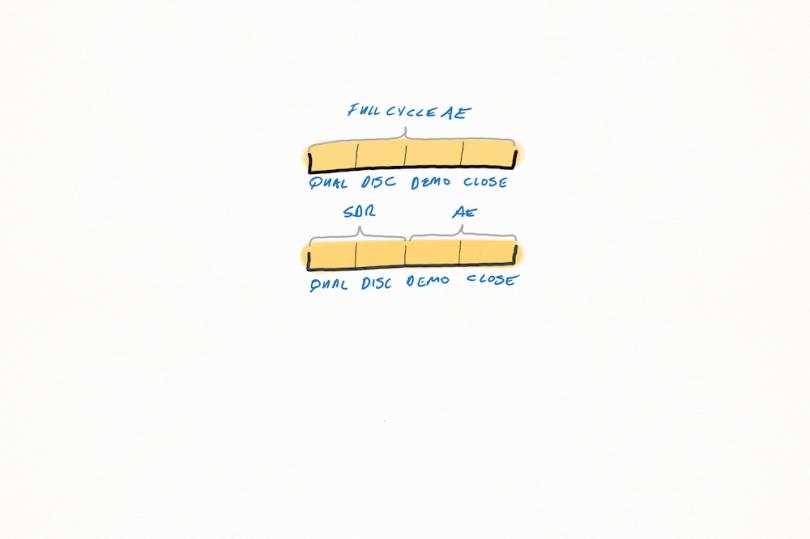For those not familiar with modern revenue generation, Predictable Revenue by Aaron Ross is practically the sales Bible. In the early 2000s, Aaron worked at Salesforce and helped to develop the modern SDR/AE (Sales Development Rep & Account Executive) sales model which reportedly brought in $100 million in new business over three years. The book is based upon his success there. I loved the book and, admittedly, it’s full of actionable insights to help any sales leader. Unfortunately, the sheer popularity of the book has catapulted the SDR/AE sales model to almost legendary default status. In my opinion, too many startups employ this model without considering their business model, market or even if customers want to buy in this way. Now 10 years after the release of the book, I believe many are beginning to see the downsides of employing this model.
Now, why do leaders employ the SDR/AE model in the first place? This model seeks to split sales into two sections where the SDR initiates the qualification and sometimes discovery process and the AE drives targeted product demonstration, negotiates and closes. Consequently, SDRs are responsible for delivering qualified opportunities to the AE and the AEs are responsible for maximizing revenue. Proponents highlight how the model allows you to train reps with a fewer number of specific skills which then opens up the hiring funnel, reduces ramp time, and promotes AE retention. In theory, there are many benefits to employing this model. In reality, there are several hidden costs to consider before you make the jump.

First, customer acquisition costs (CAC) will go up as a result of employing an SDR/AE sales model. This is surprising of course because the average SDR OTE (on-target earnings) is $76K and the average AE OTE is $160K. Leaders often arrive at a false conclusion, apparently under the mistaken impression that SDRs are cheaper than AEs. Thus they think they can double the productivity of an AE without having to pay as much. But this is just simply not true. While a great AE doesn’t necessarily need a full-time manager, the often younger SDRs need an experienced manager at the helm. The average OTE for an SDR Manager is $128K according to The Bridge Group. Add that plus any fully burdened costs like insurance, 401K, etc. Then consider the expensive tech stack needed to help SDRs be productive. A Zoominfo subscription starts at $25K. Outreach or Salesloft costs you at least $10K. The Bridge Group reports the average sales team has a tech stack of 4.5 tools. If you start adding up all the modern tools that SDRs need, you’ll begin to see that SDR teams are just as expensive as AE teams. If the costs are nearly the same, then the less experienced SDRs need to bring in more than double the new annual recurring revenue (ARR) for them to even be worth the investment. Again the model can work but sometimes it significantly increases CAC.
Losing Traction With Prospects
One of the other hidden costs associated with this model is the loss of trust from the customer. I’ve had this experience shopping for a B2B sales engagement platform. I went on the company’s website and filled out a form. The SDR set up the call with me immediately. The actual call went great. The SDR was engaged, helpful, and answered all my questions, so I told him I wanted the demo.
At this point, I’m feeling really great about the process, but then he tells me he needs to pass me off to the AE for the demo. Instead of just seeing the software, he wants to send me to someone else who can “better” help me. The most annoying part of the process? I get to the AE and he asks me some of the same exact questions I already answered.
The cost here, which we rarely recognize, is the breakdown in trust between the prospect and the seller. Since the original SDR helped me diagnose my problems, we built a connection. Admittedly not a deep one, but I certainly had more confidence in the SDR. Similar to a great mechanic or doctor, a proper diagnosis always builds greater relational trust. Collaboration of any kind increases our belief in an expert. But trust doesn’t transfer over to the AE. This results in lost sales due to a needlessly complex process.
Many of the downsides of the two-step SDR/AE model stem from the fact that no prospect wants to be handed off to another person in the first place. We’re all busy, and adding another person to the sales process just extends the length of the cycle. We all want to speak to people with the power to help us solve our problems.
Do you like when your cable provider transfers you to yet another department on the phone? How about when the doctor says they can’t help you but can only provide a referral to a specialist which you must visit another day? Does anyone at all enjoy talking to someone that can’t provide an actual solution?
Many people might say that the poor handoff from SDRs to AEs is the problem. But even the best transfer is still a transfer. In a perfect world, the first person we speak with could diagnose and solve our problem. Or perhaps, the perfect world looks more like product-led growth where the product diagnoses and solves user problems and human intervention is only necessary on the more complicated issues.
The Devolution of the Account Executive
In many ways, sales organizations are evolving to develop processes that are more aligned with the demands of modern prospects. But in other ways, sales orgs have devolved. Too many companies have blindly used the SDR/AE model and, as a result, the original Account Executive role has drastically changed for the worse.
If we look back to just 10 years ago, the Account Executive role was the primary rainmaker of the organization. They were expert “hunters,” able to skillfully qualify prospects, diagnose problems, demonstrate value, and close deals. Since these rainmakers owned the total pipeline from start to finish, they were held accountable for hitting quota. If the work depends on you, then you can’t really blame anyone else.
But my oh my how sales as a profession has changed. The full-cycle AE rainmakers are still out there. More often than not, though, owners and sales leaders have partitioned sales into two parts much like an assembly line. At the beginning, SDRs qualify or sometimes run discovery calls. Later, the AE demonstrates the product and ideally closes the deal.
When the first industrial assembly lines were introduced in the early 20th century, business owners touted some of the same benefits you’ve probably heard surrounding the two-step sales model: each team member achieves higher effectiveness because they specialize in only a few skills. They also need less specialized training because there’s less to master. Additionally, there is a clear career development path moving from SDR to AE.

At the same time, some of the same arguments against assembly lines fit the current sales context as well. First, the two-step sales model leads to boredom. Much like the assembly line worker, sales specialists have a limited amount of monotonous activities to perform. SDRs in particular touch hundreds of prospects a day. This kind of repetitive work reduces job satisfaction. Millennials in particular want to feel a sense of purpose with their work (i.e. that their work is meaningfully connected to something bigger than themselves). There is some evidence that SDRs are not happy. The average tenure for SDRs is just 18 months.
Another unfortunate outcome of this model is the shift in the AEs’ attitudes. While traditional AEs took responsibility for their early pipeline generation, many modern AEs feel prospecting is beneath them. Despite the typical difficulty of an SDR’s job in qualifying and sometimes diagnosing prospects, AEs are paid much more, up to twice as much, to execute what is admittedly an easier part of the process in the demo and closing. Although paying each role similar wages would make sense, we instead send signals that the demo and close part of the assembly line is more important with higher pay. AEs often don’t respect the hard work of prospecting.
The ironic part of all of this is if AEs want to reliably hit quota during downtimes, they have to go back to doing “lowly” prospecting work. Unfortunately, AEs who haven’t had to prospect for a while will lose this essential skill over time. Successful salespeople take ownership and hone the skills they need at every part of the sales process. The ebbs and flows of the two-step model don’t set them up for success. Additionally, SDRs and AEs will be in heated debates over what constitutes a qualified opportunity. And worst of all the AE often blames their sad sales performance on the SDR. The attitude has shifted from one of ownership to one of blame.
What you should do if you want the SDR/AE model to work
- Think about your customers and how do they want to buy from you.
- Create a culture where prospecting is held in high regard.
- Give a clear promotion path to SDRs and help them connect to the value of their work.
- Consider how you can build trust through the SDR/AE handoff. Can a live AE jump on the call?
So should you employ a specialized SDR/AE sales model? In some cases, it’s a fruitful endeavor. There have been some wildly successful companies employing this model. But there are also a number of companies showing success with using rainmaker AEs as a part of their GTM strategy. Some of these are quite popular: AppDynamics, Qualtrics, DataRobot, Shopify Plus, Drift and Darktrace. You can go in either direction. What’s more important is that we dispel the myth--there is no default path to predictable revenue anymore.





